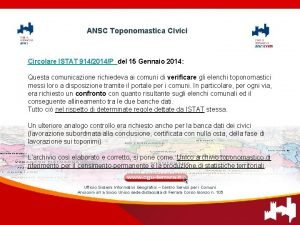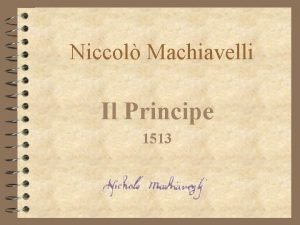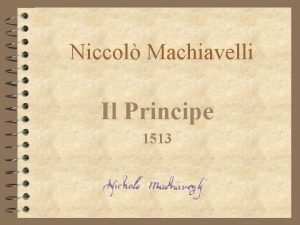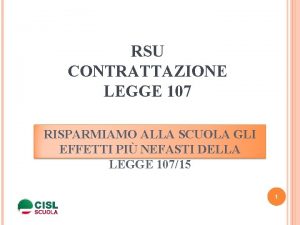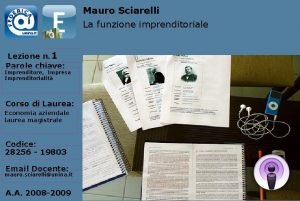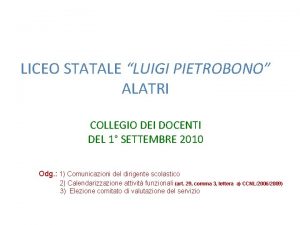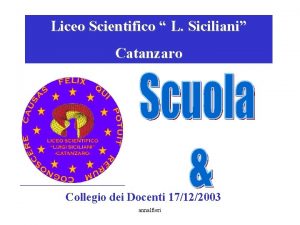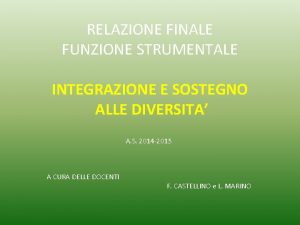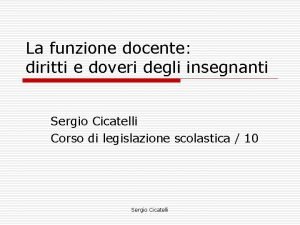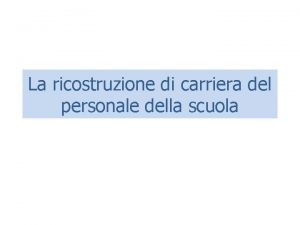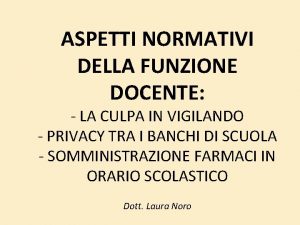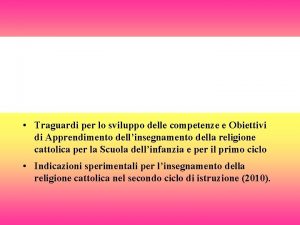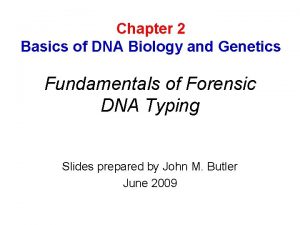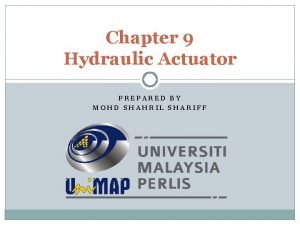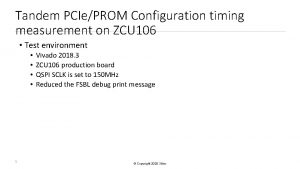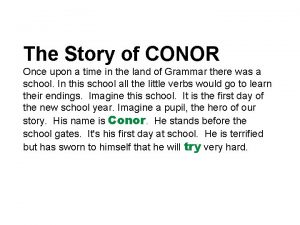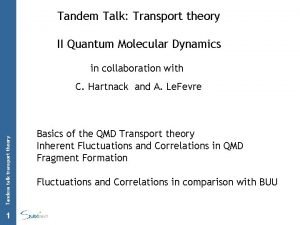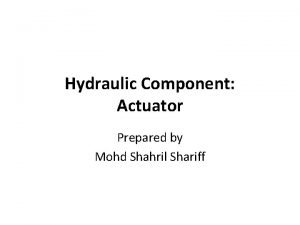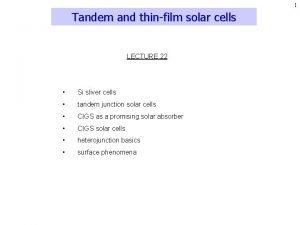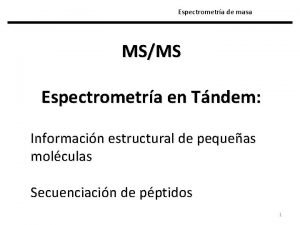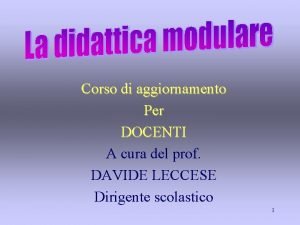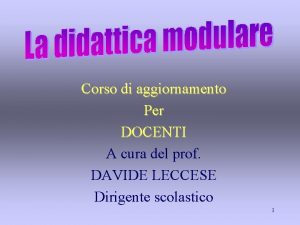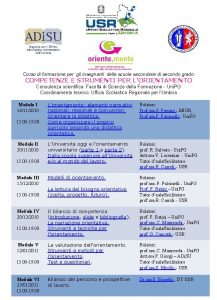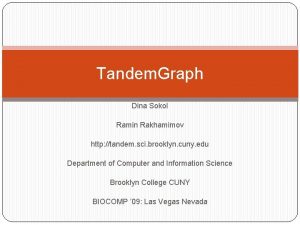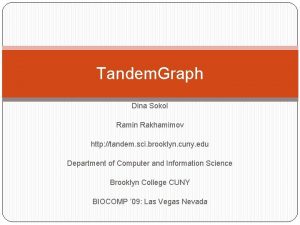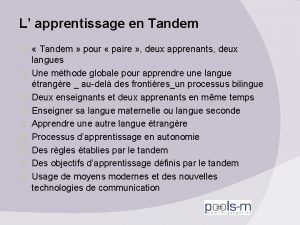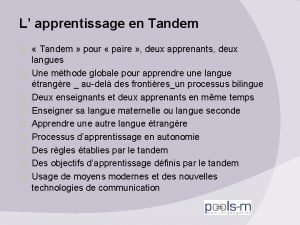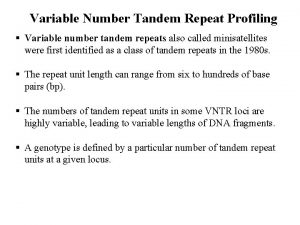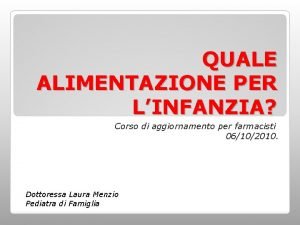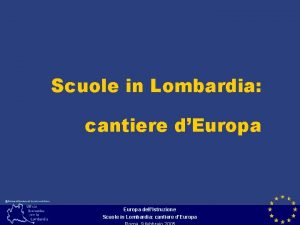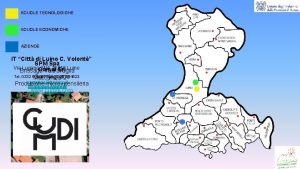CORSO TANDEM Aggiornamento per docenti delle scuole FROM













































- Slides: 45

CORSO TANDEM Aggiornamento per docenti delle scuole FROM TEXT TO SCREEN Teaching English Literature and Culture through Films 9/11/2017 (Lesson 5) anja. meyer@univr. it

1899 1976

Heart of Darkness (1899) Jospeh Conrad wrote Heart of Darkness in three episodes for Blackwood’s Magazine in 1899. Published as a book in 1902; Based on Conrad’s experience of sailing up to Congo river in 1890 (which was part of the Belgian Empire); explicit critique to European Imperialism; In his essay “Geography and some explorers” Conrad describes the colonial exploitation as “The vilest scramble for lott that ever disfigured the history of human conscience and geographical exploration; ” Narrative within the narrative. Divided into 3 main parts.

Apocalypse Now (1979) Director: Francis Ford Coppola; The filming of the movie started in February 1976 1959 to 1975); Shot in a secure large area of Philippines (substitute for Vietnam) : humid, typhoon climate and dense vegetation; The movie was released in 1979 (after two years of editing); It deals with contemporary politics in a way which is comparable to Conrad’s Heart of Darkness;

Writer / Director Joseph Conrad: polish seaman; he becomes a writer, English as third language; “Heart of Darkness”: the first novel of the 21° century. Innovative narrative techniques focusing on the inner state of the human. It paves the way to modern literature. Francis Ford Coppola: he contributed to change the way of filmmaking in Hollywood, developing the new trend of “New Hollywood. ” New subjects matters and style. “Apocalypse now”: it stands out due to the way it deals with contemporary politics (similarly to Conrad’s HOF). Pioneering with regard to the use of lights and sounds

Darkness/Apocalypse ² “Heart of Darkenss”: it refers both to the Congolese jungle with its untamed and hostile wilderness and to a state of mind and the grim consequences of imperialism. “Apocalypse” : the end of the world, the earth destroyed by fire in the Bible. Religious imagery of fallen achangels, Antichrist. The metaphorical “darkness” of Vietnam War causes an apocalypse in the hearts of those sent there to fight.

Plot Heart of Darkness and Apocalypse Now share a common plot line: - The Journey: a restless protagonists is sent on a mission to an underdeveloped part of the world, where he encounters the natives and the wilderness on a boat trip along the river, which is surrounded by a jungle. During this journey they witness unthinkable atrocities. - The river and the jungle are predominant parts of the setting in both works of art. - In both stories, operating beyond the constraints of civilized society for an extended period leads to insanity; - At the end of the river he meets Kurtz, who has spent a long time by himself and in contact with wilderness. He seems to be gone insane. The protagonist is both abhorred and attracted

Setting Heart of Darkness Apocalypse now - Set in Congo during colonialism at the end of the 19 th century. - Set in the jungles of Vietnam during the vietnam War in the late ‘ 60 s. - Two rivers: Thames and Congo River. - Nung River from Vietnam to Cambodia

Characters: Marlow/Willard Heart of Darkness - Marlow, an English sailor on quest to meet Kurtz; - He is the captain of a boat which takes him up the river; - Deep psychological insights; Apocalypse Now -Willard: an U. S. Army special forces operative on a mission to kill Kurtz; -He is not the captain of the boat; -He is sent on his mission specifically to kill Kurtz; - In both of them the growing fascination for Kurtz becomes an obsession.

Characters: Willard

Characters: Kurtz/Kurtz Heart of Darkness - Kurtz is a famous ivory trader; the best agent of the Company - Marlow looks forward to meeting him Apocalypse Now - Kurtz is an outstanding military officer; - He is reported to have gone insane; - He leads a small colony in Cambodia; - Same kind of personality: Kurtz rules the natives and he is a sort of god for them; - Inconsistent personality traits: universal genius with moral ideas, but he uses “unsound methods” - They posses the quality of eloquence;

Characters: Kurtz Interpreted by Marlon Brando: corpulent and imposing physical presence constrasts with the appearance of Kurtz in Ho. D; - His Kurtz is broad and large, with an imposing and sinister presence. In Heart of Darkness Kurtz is described by Marlow: “I could see the cage of his ribs […], the bones of his arms waving

Chapter I: opening The Nellie, a cruising yawl, swung to her anchor without a flutter of the sails, and was at rest. The flood had made, the wind was nearly calm, and being bound down the river, the only thing for it was to come to and wait for the turn of the tide. The sea-reach of the Thames stretched before us like the beginning of an interminable waterway. […] “And this also, ” said Marlow suddenly, “has been one of the dark places of the earth. ” He was the only man of us who still “followed the sea. ” The worst that could be said of him was that he did not represent his class. He was a seaman, but he was a wanderer, too, while most seamen lead, if one may so express it, a sedentary life. […] “One day he remarked, without lifting his head, ‘In the interior you will no doubt meet Mr. Kurtz. ’ On my asking who Mr. Kurtz was, he said he was a first-class agent; and seeing my disappointment at this information, he added slowly, laying

Chapter I: opening - Narrative frame: one of the listeners on the Nellie explains the circumstances in which Marlow tells his story, that is the main narrative. The writer in this technique does not involve himself in the events, but keeps himself at a distance. - Unnamed narrator (the other listeners are identified only by their profession– they represent conventional perspectives of the British establishment. ) - Narrator attitude: he expresses the mainstream belief that imperialism is a glorious and worthy enterprise; - Marlow starts telling his experience as a young man who captained a steamship going up the Congo River. (Belgian Company). I-narration. - Marlow’s point of view: he’s very critical of Imperialism.

Opening Sequence (0 : 0. 7. 27) Original use of the cinematic codes; Long shot of a green jungle in the background, helicopters cross the screen from right to left and vice versa accompanied by the sound of rotor blades; the jungle bursts into flames and the viewer hears the soundtrack This is the End by the Doors; the jungle in grey colours with small fires burning everywhere overlapped by the face of a man that is rotating; The shot shifts to the next scene in a hotel room in Saigon, where the camera zooms on a rotating fan; The noise associated with the helicopter in now transposed to the fan. It seems to be a dream. Introduction of the protagonist of the main story: the man is a soldier on leave, perhaps thinking of the war in the jungle.

The protagonist’s point of view The frame narratives in Heart of Darkness and Apocalypse Now share the introduction of the protagonist; Heart of Darkness: the main narrative is told by Marlow in the form of an I-narration; Apocalypse Now: the main narrative is told through the filter of Willard: - the camera often zooms on his face, - the viewer looks at the scenery from Willard’s optical point of view suggesting “subjectivity” (ex: when Willard looks out of the window from the hotel room in Saigon ) frequent use of Willard’s voice-over

SOUND: Opening Sequence “This is the end, beautiful friend This is the end, my only friend, the end Of our elaborate plans, the end Of everything that stands, the end No safety or surprise, the end I’ll never look into your eyes… again The End. . . ” (The Doors, “The End”)

SOUND: Opening Sequence - sound can be used to manipulate audience expectations and comprehension of what is real or imaginary; - Different sources: helicopters, the fan in a hotel room, napalm explosions, jungle noises, a smashed mirror, the Doors’ recording of “The End, ” voice-over narration, dialogue; - many of these sounds are distorted or slowed down to characterize both the dreamlike, otherworldly quality of the setting and Captain Willard’s (Martin Sheen) state of mind; - First words of voice-over: “Saigon. Shit!” (the jungle is where he wants to be - pictures and sound prepare us for many of the movie’s key

The civilized West - Refined food being served, while a classical piano is being played; - Comforting atmosphere in contrast with the previous images; - Willard is given the mission to terminate Kurtz First appearence of KURTZ: - Photographic image; - Registration of his voice; - Description

War scene Willard is taken to the camp of Colonel Kilgore; Scene of an air-attack: Kilgore risks the lives of his troop and fights the Viet Cong village for the sake of of gaining a good place for surfing; Images symbolizing the absurdity of war: a cow being picked up by an helicopter; battlefield Catholic mass; a soldier surfing on a wave caused by napalm bombing. Sense of confusion, disorder, demoralization; Racist overtones; The Vietnamese are called “fucking savages”

Images symbolizing the absurdity of war a cow being picked up by a helicopter a battlefield Catholic mass a soldier surfing on a wave caused by napalm bombing

War scene: sound (37. 30 -45. 00) the soundtrack is used to reinforce the notion of war’s absurdity; Kilgore blasts Wagner’s "Ride of the Valkyries" to announce a senseless, unnecessary air strike; pairing such a bombastic composition with the atrocities that unfold below is absurd nearly to the point of comedy; the combination of triumphant music and deadly combat creates a sense of madness (reinforced by Kilgore’s unconventional "surf or fight" methods)

“ They wandered here and there with their absurd long staves in their hands, like a lot of faithless pilgrims bewitched inside a rotten fence. The word ‘ivory’ rang in the air, was whispered, was sighed. You would think they were praying to it. A taint of imbecile rapacity blew through it all, like a whiff from some corpse. By Jove! I’ve never seen anything so unreal in my life. And outside, the silent wilderness surrounding this cleared speck on the earth struck me as something great and invincible, like evil or truth, waiting patiently for the passing away of this fantastic invasion. ” (Ch. II, Heart of Darkness)

Madness In Ho. D Marlow compares the journey to travelling back in history; The journey up the river becomes a journey in the darkest part of the self; Each member of the crew experiences his own kind of mental breakdown; Ex. Scene (0. 56. 20 -1. 00): Willard and Chef get out of the boat to find a mango tree in the jungle. They are frightened by a tiger which leads to an insane gunfire in the direction of the jungle; Chef experiences a mental breakdown;

“pulled the string of the whistle, and I did this because I saw the pilgrims on deck getting out their rifles with an air of anticipating a jolly lark. At the sudden screech there was a movement of abject terror through that wedged mass of bodies. ‘Don’t! don’t you frighten them away, ’ cried some on deck disconsolately. I pulled the string time after time. They broke and ran, they leaped, they crouched, they swerved, they dodged the flying terror of the sound. The three red chaps had fallen flat, face down on the shore, as though they had been shot dead. Only the barbarous and superb woman did not so much as flinch, and stretched tragically her bare arms after us over the sombre and glittering river. “And then that imbecile crowd down on the deck started their little fun, and I could see nothing more for smoke. ”

Scene: Playboy bunnies American culture infiltrated into the Vietnam War; a group of Vietnamese onlookers (some of them children) is watching the spectacle from behind a chain link fence; natives always in the background; one of the few instances where female characters appear in in the movie. They have no lines. They are just the photographs coming into life; What was meant to be a patriotic reminder that America still cares about them turns into a sad reality check; Coppola wanted this scene to be bizarre and detached from reality, which adds to his cynical perspective on the war itself.


The French plantation (1. 58 -2. 10) Last bastion of civilazation; symbolized by the scene of the burial. Clean is the last one to be properly buried in the ground; first stop on the journey backwards in the history of Vietnam. Coppola said he wanted the progress up the river to look like going back in history: the plantation stands for what remained from the colonization of French Indochina (1950 s); immersed in fog so that it is not clear whether it is a dream or reality ; character of the widow that Willard spends the night with. She could be seen as a counterpart of the black savage

The helmsman (2. 20 -2. 25) He is present both in Heart Darkness and in Apocalypse Now (his name is Chief) of He is a member of the crew on the boat during the mission; In both works of art he is set apart from the whites due to his black skin colour; They are killed during an attack by the natives. In both versions the corpse of the helmsman is given to the current. In the movie it contrasts with the burial of Clean: it symbolizes the further moving from the signs of

The helmsman in Heart of Darkness I missed my late helmsman awfully—I missed him even while his body was still lying in the pilot-house. Perhaps you will think it passing strange this regret for a savage who was no more account than a grain of sand in a black Sahara. […] I hugged him from behind desperately. Oh! he was heavy, heavy; heavier than any man on earth, I should imagine. Then without more ado I tipped him overboard. The current snatched him as though he had been a wisp of grass, and I saw the body roll over twice before I lost sight of it for ever. Heart of Darkness

Final part: ituals and sacrality - A. N: While proceeding they see dead bodies, burning buildings and altars with andles on the shore / getting closer to something sacred, ritualistic; - Marlow: “But this must have been before his—let us say—nerves, went wrong, and caused him to preside at certain midnight dances ending with unspeakable rites, which—as far as I reluctantly gathered from what I heard at various times—were offered up to him—do you understand? ” (Heart of

Final part natives in little boats letting Willard’s crew pass by and then closing the way behind them – It reminds of the jungle closing its door behind Marlow’s steamboat in the novel; Both versions suggest a journey from which there is no coming back Like Marlow’s crew in the novel, Willard’s crew is met by Kurtz’s disciple: the Russian. In the movie, he is turned into the photojournalist.

Characters in Ho. F: The Russian Don’t you talk with Mr. Kurtz? ’ I said. ‘You don’t talk with that man—you listen to him, ’ he exclaimed with severe exaltation. […]‘Brother sailor. . . honour. . . pleasure. . . delight. . . introduce myself. . . Russian. . . son of an arch-priest. . . Government of Tambov. . . What? Tobacco! English tobacco; the excellent English tobacco! Now, that’s brotherly. Smoke? Where’s a sailor that does not smoke? ” […] ‘What can you expect? ’ […] He could be very terrible. You can’t judge Mr. Kurtz as you would an ordinary man. No, no! Now—just to give you an idea—I don’t mind telling you, he wanted to shoot me, too, one day—but I don’t judge him. ’ ‘Shoot you!’ I cried ‘What for? ’ ‘Well, I had a small lot of ivory the chief of that village near my house gave me. […]. I gave him the ivory. What did I care! But I didn’t clear out. No, no. I couldn’t leave him.

Kurtz in Ho. D I could not hear a sound, but through my glasses I saw the thin arm extended commandingly, the lower jaw moving, the eyes of that apparition shining darkly far in its bony head that nodded with grotesque jerks. Kurtz—that means short in German —don’t it? Well, the name was as true as everything else in his life—and death. He looked at least seven feet long. His covering had fallen off, and his body emerged from it pitiful and appalling as from a winding-sheet. I could see the cage of his ribs all astir, the bones of his arm waving. It was as though an animated image of death carved out of old ivory had been shaking its hand with menaces at a motionless crowd of men made of dark and glittering bronze. I saw him open his mouth wide—it gave him a weirdly voracious aspect, as though he had wanted to swallow all the air, all the earth, all the men before him. A deep voice reached me faintly.

Kurtz in Apocalypse Now - dim lighting which indirectly suggests his untouchable status and creates a distance between him and chained Willard; - He is broad and large, with an imposing and sinister presence; - Kurtz’s face is painted which signifies his god-like status (or a savage during a ritual); - He reads The Hollow Men by T. S. Eliot, suggesting his opinion about military intelligence;

Kurtz’s death Heart of Darkness: I was fascinated. It was as though a veil had been rent. I saw on that ivory face the expression of sombre pride, of ruthless power, of craven terror—of an intense and hopeless despair. […] He cried in a whisper at some image, at some vision—he cried out twice, a cry that was no more than a breath: ‘The horror!’ Apocalypse Now: Willard paints his head the same way as Kurtz did before. He enters Kurtz’s chamber and attacks him with the machete. The scene is interwoven with that of natives slaughtering a buffalo as a tribute during a festival dedicated to Kurtz is slaughtered like a cow. His last words:

Credits and ending scenes https: //www. youtube. com/watch? v=0 X_XSq. Oyz. E

Main differences

Main themes v The Hypocrisy of Western Imperialism: Willard’s mission is the epitome of hypocrisy: in the midst of senseless killings, the U. S. military is wasting energy and lives on killing one of greatest military officials v Instead of helping innocent civilians, American troops kill them. v Madness As a Result of War : The film is a metaphor for a journey into the self and shows how the self, in the face of war, darkens beyond recognition. As they move upriver, Willard and the PBR crew become more agitated and separated from reality. Each experiences his own kind of mental breakdown v The Emptiness of American Values : the values the Americans fight for are a combination of surfing, Playboy Playmates, and psychedelic rock. - In showing the Playmates in Vietnam, the film highlights the


Colors They mirror the journey itself; Start: deeply saturated colors, putting us in a different realm of our imagination; bright colors; As the journey begins, the color of the fog appears. By the end it is so thick that neither Willard nor we can see anything clearly anymore; As we go further and deeper in the journey, the colors start getting muted; Sepia tone and give a representation of an altered reality. This is the other world; the colors of this world are different; End: colors are completely changed and the palette is in

Lights and shadow

Lighting - Lighting is the key element in the film; - Every character’s face is only half-lit. There are very few completely lit faces. As the journey goes on, this becomes more and more obvious and extreme. - Strong shadows on faces underling the duality of human nature (ordinary and evil); - The general look of the film is dark and shadowy (despite the colors); - As the journey begins, the lights are still high, Willard begins his boat ride in dusk, but as the journey gets deeper and deeper, the film gets darker, the shadows get pronounced and light is dimmed. Use of heavy fog in different colors in war scenes. Fog is used extensively in the film representing the haze and the confusion of a seemingly endless war.

Symbols MASKS: Masks are used at key points in the film to symbolize the anti-self, the new identity assumed in order to deal with the war, an act that requires a symbolic killing of the old self. By the end of the movie, numerous characters have donned masks or painted their faces with camouflage, signs that they are no longer themselves. THE RIVER: The fictional Nung River is the setting of a literal and metaphorical journey; While the river leads Willard to a place of death and despair, in the final scene it is also Willard’s escape route; FOG: suggests confusion and alienation for Willard and the rest of the crew, as they journey upriver into the unknown.

“My task which I am trying to achieve is, by the power of the written word, to make you hear, to make you feel – it is, above all, to make you see” Joseph Conrad
 Ic camigliano
Ic camigliano Aggiornamento ansc
Aggiornamento ansc Istituto griselli
Istituto griselli Scuole superiori viadana
Scuole superiori viadana Unife scuole di specializzazione
Unife scuole di specializzazione La scuola è pubblica amministrazione
La scuola è pubblica amministrazione Istituto comprensivo trento 5
Istituto comprensivo trento 5 Haccp ppt italiano
Haccp ppt italiano Gestione per conto dello stato
Gestione per conto dello stato La lezione delle antique cose
La lezione delle antique cose La nascita delle lingue e delle letterature romanze
La nascita delle lingue e delle letterature romanze L esperienza delle cose moderne e la lezione delle antique
L esperienza delle cose moderne e la lezione delle antique Sostituzione docenti assenti scuola infanzia
Sostituzione docenti assenti scuola infanzia Mauro sciarelli unina
Mauro sciarelli unina Iis pietrobono alatri
Iis pietrobono alatri Dpr 89/2009 slide
Dpr 89/2009 slide Docenti unina cantone
Docenti unina cantone Ic gullo cosenza docenti
Ic gullo cosenza docenti Liceo scientifico siciliani catanzaro docenti
Liceo scientifico siciliani catanzaro docenti Relazione finale referente sostegno
Relazione finale referente sostegno Diritti e doveri degli insegnanti
Diritti e doveri degli insegnanti Temporizzazione docenti
Temporizzazione docenti Culpa in vigilando docenti
Culpa in vigilando docenti Valmon unife
Valmon unife Itc zanon
Itc zanon Easyacademy unipr
Easyacademy unipr Traguardi per lo sviluppo delle competenze irc
Traguardi per lo sviluppo delle competenze irc Short tandem repeat
Short tandem repeat Tandem cylinder symbol
Tandem cylinder symbol Sequence polymorphism
Sequence polymorphism Tandem fundazioa
Tandem fundazioa Tandem pcie
Tandem pcie Mercator tandem proficisci constituit
Mercator tandem proficisci constituit Tandem
Tandem Tandem talk
Tandem talk Tandem technique in ultrasonic testing
Tandem technique in ultrasonic testing Tandem unil
Tandem unil Gambar double acting cylinder
Gambar double acting cylinder Tandem walking exercise
Tandem walking exercise Tandem offline
Tandem offline Tandem language
Tandem language Tandem
Tandem Brachytherapy
Brachytherapy Short tandem repeats
Short tandem repeats Tndem
Tndem Tandem walking exercise
Tandem walking exercise

